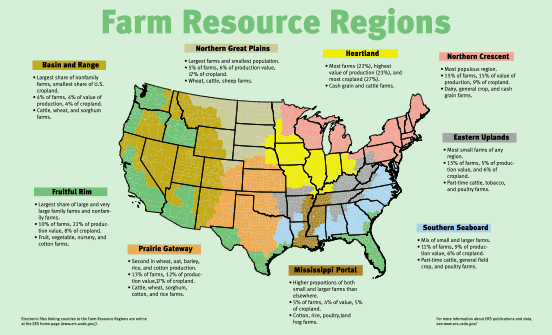MARKETING...

In the Cattle Markets
Consider regional variation in cow-calf returns.
As producers continue to make both short-term and longer-term decisions in managing their operations, it is useful to periodically step back and take stock of characteristics depicting the industry more broadly. The recently updated estimates from USDA’s Economic Research Service (ERS) of production costs and returns offer an opportunity to increase our understanding of regional variation in the U.S. cow-calf sector.1
Twice a year, USDA ERS considers returns in nine different regions, as well as the country as a whole (see map above). Table 1 provides a summary of how production costs and returns per bred cow varied regionally in 2015. Overall, the significant variation across regions reflects a host of factors, including differences in land use, weaning weights and operation size. Read more.
Producer Groups React
to Release of USITC Report
U.S. International Trade Commission outlines impacts of TPP on U.S. economy in recent report.
On May 18 the U.S. International Trade Commission (USITC) released its report outlining the economic effects of the Trans-Pacific Partnership (TPP) on the U.S. economy. Producer groups’ responses to the report were largely positive, with a few groups showing skepticism toward TPP.
TPP negotiations were initiated in late 2008 and concluded last October. The agreement is a regional trade deal that includes the United States, Australia, Brunei Darussalam, Canada, Chile, Japan, Malaysia, Mexico, New Zealand, Peru, Singapore and Vietnam, which account for nearly 40% of global gross domestic product (GDP). The countries combined have more than 800 million consumers. Read more.
Launching Second 30-Day Protein Challenge
The 30-Day Protein Challenge provides a step-by-step plan to get an optimal amount of protein throughout the day.
The checkoff's “Beef. It’s What’s For Dinner.” brand will launch its second 30-Day Protein Challenge campaign this month. Americans currently consume two-thirds of their total daily protein intake at dinner, which doesn’t leave much room for protein at other meals or snacks. The 30-Day Protein Challenge provides a step-by-step plan to get an optimal amount of protein throughout the day.
The first launch of the Protein Challenge in 2015 was extremely successful, exceeding benchmark metrics set for the campaign, including more than 14,000 email campaign subscriptions, 81,000+ email opens and click-thrus, and more than 164,000 visits to the Protein Challenge landing page during the campaign period. Read more.
What’s in a Number?
What does 30.1% mean to you?
Numbers are everywhere. They matter to a rancher, so they matter to the Certified Angus Beef® (CAB®) brand. A natural progression, CAB’s Black Ink team set out to uncover stories behind both common and irregular numbers that affect a cattleman’s future. From 120 million to -2.26, each one tells a story of how even the seemingly random and only slightly related are intertwined to impact profitability. Read more.

Ginette Gottswiller
The Source
The search for simplicity.
At the end of the day, if we sell our calves for a good price, there were not too many open cows and the feed prices didn’t cut into our profit margin too much, isn’t that good enough? Don’t you just need a good market and some buyers bidding the day you sell? Who needs to wean, vaccinate or enroll in a value-added program?
Producers who follow this philosophy are the same producers who complain their calves didn’t bring as much as the neighbor's calves down the road. “They looked just like the black-hided calves I just sold. Why did his calves bring more money?”
There could be a number of reasons, so let’s take a look at some factors that could affect the price you receive for your calves. Read more.
U.S. Beef Arrives in
Reopened South African Market
First U.S. beef is exported to South Africa since 2003.
The USDA confirmed on May 16 that the first shipment of U.S. beef arrived in South Africa following the reopening of the South African market earlier this year.
“The arrival of U.S. beef in South Africa represents another important milestone in efforts by USDA and the Office of the U.S. Trade Representative to regain access to this important market,” said Ag Secretary Tom Vilsack. “Along with U.S. poultry, South African consumers now have access to high-quality, safe and wholesome U.S. beef, and U.S. producers and exporters have gained another valuable market for their products.” Read more.
How the Beef Value System Works
Ag economist Ted Schroeder, of Kansas State University, discusses how premiums filter back from beef consumer to beef producer in this video news release from the Certified Angus Beef® (CAB®) brand.
Angus Calendar
To view the Angus Calendar, a complete list of Angus sales, click here.






